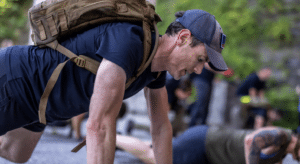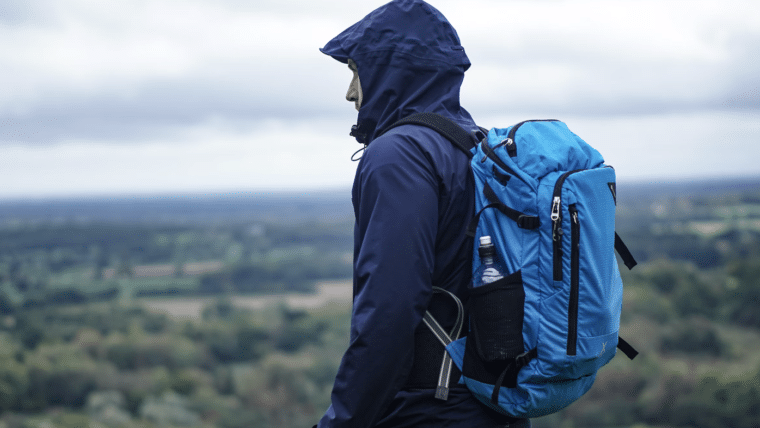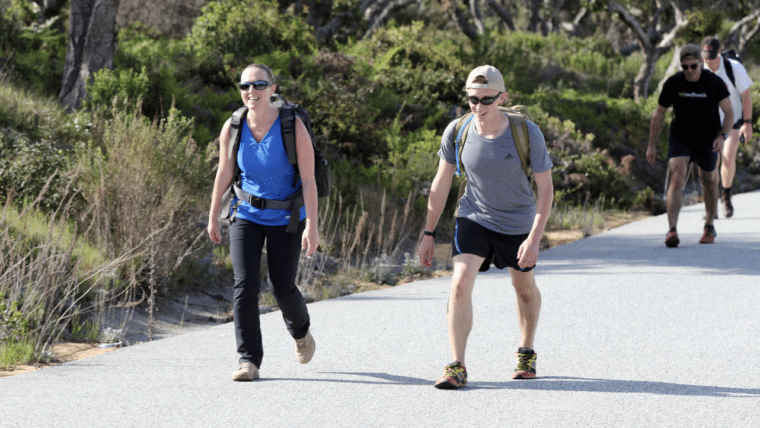Rucking is gaining popularity as a functional fitness activity that offers a simple and effective way to improve overall fitness. Whether you’re a beginner or a seasoned pro, these top tips will help you enhance your rucking experience and achieve success in your workouts.
From choosing the right backpack to improving your rucking technique, these tips cover everything you need to know to get the most out of your rucking workouts.
Key Takeaways:
- Choose the right backpack for optimal comfort and function.
- Load your ruck with weight close to your spine for balance.
- Pack water and snacks to stay hydrated and fueled during rucks.
- Gradually increase distance and weight as you progress.
- Focus on maintaining good posture and avoid running while rucking.
How to Start Rucking
Starting rucking is as easy as following these four simple steps:
- Get the right backpack: Choose a backpack that balances durability, comfort, and function. Look for one specifically designed for rucking, with features like padded straps and a supportive frame. Here’s our top rucking backpack list.
- Load your ruck with weight: Place the weight high and close to your spine for optimal balance. Start with a lighter load and gradually increase it as you get stronger. Remember to distribute the weight evenly to avoid strain.
- Pack water and snacks: Hydration and nutrition are important during rucking. Pack a water bottle or hydration bladder (here are some we love) and bring along some snacks to keep you fueled and energized throughout your rucks.
- Start walking: Begin with shorter distances and gradually increase your distance and weight as you progress. Focus on maintaining a steady pace and proper form while walking.
Starting rucking is a great way to improve your fitness and enjoy the outdoors. Follow these steps, and you’ll be well on your way to a successful rucking journey!

15 Rucking Tips
If you’re getting started with rucking or looking to improve your technique, these 15 rucking tips will help you get the most out of your workouts. From the essential prep tips to keeping it fun, these tips cover everything you need to know to enhance your rucking experience.
- Get the right rucking backpack: Investing in a durable and comfortable rucking backpack is crucial. Look for one that allows for proper weight distribution and has adjustable straps for a personalized fit.
- Wear wool socks: To prevent blisters and keep your feet comfortable, opt for moisture-wicking wool socks that offer cushioning and breathability. Here are our favorite Rucking Socks.
- Maintain good posture: Keep your shoulders back, spine straight, and engage your core to maintain proper posture while rucking. This will help prevent strain on your back and promote optimal movement.
- Avoid running while rucking: Running with a heavy rucksack can increase the risk of injury. Focus on maintaining a steady pace and avoid the temptation to break into a run.
- Gradually increase weight and distance: Start with a manageable weight and distance, and gradually increase both as your strength and endurance improve. This will help prevent overexertion and reduce the risk of injury.
- Engage your upper body: Incorporate exercises that engage your upper body, such as shoulder presses, rows, and push-ups, to build strength and improve your rucking performance. Here is a site with hundreds of rucking workouts.
- Make it fun: Rucking doesn’t have to be monotonous. Explore new routes, listen to music or podcasts, or ruck with a friend to keep your workouts enjoyable and engaging.
- Stay hydrated: Proper hydration is key during rucking. Pack enough water and make sure to take regular sips to stay hydrated and maintain optimal performance.
- Choose the right shoes: Opt for sturdy and supportive footwear that provides stability and protects your feet. Look for shoes with good traction to navigate various terrains effectively. Our sister site, Ruck.Beer, has a great overview of the GORUCK footwear lineup, many of which are built for rucking.
- Practice proper breathing: Focus on deep, controlled breathing to oxygenate your muscles and improve your endurance. Breathe in through your nose and exhale through your mouth.
- Take care of your gear: Regularly inspect and maintain your rucking gear to ensure it remains in good condition. Clean your backpack, check straps for wear and tear, and replace any damaged or worn-out equipment.
- Stretch before and after: Prioritize stretching before and after your rucking workouts to warm up your muscles, improve flexibility, and prevent injuries.
- Involve a friend: Rucking with a buddy can provide motivation, accountability, and make your workouts more enjoyable. Find a rucking partner and hit the trails together.
- Embrace the burn: Rucking is a challenging workout, but embracing the burn and pushing through discomfort will help you build mental toughness and achieve your fitness goals.
- Join a rucking community: Engage with other ruckers by joining online forums (like our Rucking Facebook Group) or local rucking groups. Sharing experiences, tips, and stories will not only help you learn but also provide a sense of community.
By incorporating these rucking tips into your fitness routine, you’ll be on your way to improving your rucking technique, increasing the burn, and keeping it fun. So, lace up your shoes, strap on your backpack, and start rucking today!
Ruck Marching Tips
When it comes to ruck marching, there are several important factors to consider to ensure a successful and comfortable experience. Here are some essential ruck march tips:
- Foot Protection: Protecting your feet is crucial during ruck marching. Invest in high-quality socks and consider using blister-prevention products to minimize discomfort and potential injuries.
- Choose the Right Boots: Selecting the right boots is essential for a comfortable and efficient ruck march. Opt for boots that provide adequate ankle support, have a sturdy sole for traction, and are suitable for the terrain you’ll be traversing. We recommend the MACV2 Rucking Boots or the MACV1 High Speed Rucking Boots.
- Training: Before embarking on longer ruck marches, gradually build up your endurance and strength through specific training exercises. Incorporate walking or hiking with a weighted backpack into your fitness routine to prepare your body for the demands of ruck marching.
- Workouts for Rucking: Enhance your ruck marching performance by incorporating specific workouts into your training regimen. Focus on exercises that target the muscles used during rucking, such as squats, lunges, and shoulder presses.
- How to Pack a Rucksack: Properly packing your rucksack is essential to maintain balance and comfort during your ruck march. Distribute the weight evenly and place heavier items closer to your back for better stability.
By following these ruck marching tips, you’ll be well-prepared for your rucking workouts and minimize the risk of discomfort or injuries. Remember to start slowly, listen to your body, and gradually increase the distance and weight as you progress. Happy rucking!
Posture while Rucking
Maintaining correct posture is essential when it comes to rucking. It not only helps to prevent unnecessary strain on your back, shoulders, and neck, but it also ensures that you get the most out of your rucking workouts. One key aspect of correct posture while rucking is avoiding the forward lean. This forward lean can lead to discomfort and potential injuries. Instead, focus on keeping your back straight and maintaining proper alignment of your shoulders and back.
Avoiding the forward lean starts with a conscious effort to engage your core muscles. By actively engaging your core, you can help to stabilize your body and maintain an upright posture while rucking. Additionally, it’s important to pay attention to the alignment of your back and shoulders. Keep your shoulders back and relaxed, and avoid rounding your back as you walk. This will help to distribute the weight of the rucksack evenly across your body and minimize strain on specific areas.
If you find it challenging to maintain correct posture while rucking, consider incorporating exercises that improve your core strength and posture into your regular fitness routine. This can help to strengthen the muscles that support your spine and improve your overall posture. Remember, practicing good posture not only enhances your rucking experience, but it also promotes better alignment and reduces the risk of injuries.
Tips for Maintaining Correct Posture while Rucking:
- Engage your core muscles to stabilize your body
- Keep your back straight, avoiding the forward lean
- Maintain proper alignment of your shoulders and back
- Focus on keeping your shoulders back and relaxed
- Avoid rounding your back as you walk
Use a Hip Belt
If you want to maximize your comfort and reduce strain on your shoulders and back during rucking workouts, using a hip belt is a game-changer. A hip belt helps distribute the weight of your rucksack evenly across your body, allowing you to maintain better balance and posture. By shifting some of the load to your hips, you can minimize the pressure on your shoulders and avoid unnecessary strain.
When using a hip belt, it’s important to adjust it properly to ensure optimal weight distribution. Start by securing the hip belt around your waist, making sure it sits snugly on your hips. Avoid wearing the hip belt too high or too low, as this can affect the distribution of weight. Once the hip belt is in place, tighten it enough to provide support without restricting your movements.
Benefits of using a hip belt:
- Improved weight distribution: A hip belt helps distribute the weight of your rucksack evenly across your body, reducing strain on your shoulders and back.
- Better balance and posture: By shifting some of the load to your hips, a hip belt allows you to maintain better balance and posture during your rucking workouts.
- Increased comfort: The proper use of a hip belt can significantly enhance your comfort while rucking, allowing you to focus on your workout without distractions.
Using a hip belt can greatly improve the comfort and effectiveness of your rucking workouts. Distributing the weight evenly across your body reduces strain on your shoulders and back, allowing you to ruck longer and with greater ease. Don’t underestimate the difference a well-adjusted hip belt can make in your overall rucking experience.
Remember, a hip belt is not a replacement for proper backpack fit and weight distribution. It is a complementary tool that can enhance your rucking workouts. Along with using a hip belt, make sure to follow other essential rucking tips, such as selecting the right backpack, maintaining good posture, and gradually increasing your distance and weight. With these strategies in place, you’ll be well on your way to achieving success in your rucking endeavors.
Hydration
Staying hydrated is crucial when it comes to rucking. Proper hydration helps prevent fatigue, maintain peak performance, and regulate body temperature. It is essential to pack enough water for your rucks to ensure you have an adequate supply throughout your workout. Remember, dehydration can lead to decreased energy levels and negatively affect your overall performance.
To stay hydrated while rucking, it is recommended to carry a water bottle or one of our recommended hydration bladder in your backpack. Make sure to choose a backpack with a dedicated hydration pocket or compartment to securely hold your water container. This will make it easy to access and drink water whenever needed without interrupting your rucking flow.
It’s important to drink water before, during, and after your rucking workouts. While rucking, listen to your body and drink water frequently, especially on longer and more intense rucks. After your ruck, continue to replenish your body by drinking additional water to aid in recovery and hydration.
Remember, staying hydrated is key to optimizing your rucking performance and ensuring a safe and enjoyable experience. So, prioritize water intake and pack enough fluids to keep yourself hydrated throughout your rucking adventures.
Nutrition
Proper nutrition is essential for fueling your body and maximizing your performance during rucking workouts. To ensure you have the energy and endurance to push through, it’s important to maintain a balanced diet that includes a variety of nutrient-rich foods.
When it comes to fueling your body for rucking, snacks play a crucial role. Opt for snacks that provide sustained energy, such as trail mix, protein bars, and fruit. These snacks are easy to pack, convenient to consume on the go, and provide the necessary nutrients to keep you going.
In addition to snacks, be sure to include a variety of whole foods in your diet. Incorporate lean proteins, like chicken and fish, to support muscle recovery and growth. Include complex carbohydrates, such as whole grains and sweet potatoes, to provide long-lasting energy. And don’t forget about fruits and vegetables, which are packed with essential vitamins and minerals to keep your immune system strong.
To stay properly hydrated and maximize your performance, drink plenty of water throughout the day. During your rucking workouts, aim to consume water or an electrolyte-rich beverage to replenish lost fluids. Hydration is key for maintaining energy levels and preventing fatigue.
Don’t Stop
Rucking can be physically and mentally challenging, but perseverance is key to overcoming these obstacles and achieving success in your workouts. Pushing through challenges is an essential part of rucking, as it helps you build mental toughness and resilience.
When you feel like giving up, remind yourself why you started rucking in the first place. Focus on your goals and the progress you’ve made so far. Remember that the discomfort and fatigue you may feel during a ruck are temporary and will ultimately contribute to your overall fitness and strength.
“Strength doesn’t come from what you can do. It comes from overcoming the things you once thought you couldn’t.” – Rikki Rogers
Developing mental toughness is not an easy feat, but it is an essential skill that can positively impact various areas of your life. Rucking provides an opportunity to push past your limits and discover the reservoirs of strength within you. Embrace the challenges, embrace the discomfort, and embrace the growth that comes from persevering through them.
Stay motivated with these tips:
- Set specific, achievable goals to track your progress and stay motivated.
- Find a rucking buddy or join a community to share experiences and support each other through the tough moments.
- Use positive affirmations and visualization techniques to boost your mental resilience.
- Break your rucks into smaller milestones and celebrate each achievement along the way.
Remember, the path to success is not always easy, but it is always worth it. Embrace the challenges, stay committed, and keep pushing forward. With perseverance and mental toughness, you’ll conquer any obstacle that comes your way and achieve your rucking goals.
Conclusion
In conclusion, rucking is a fantastic fitness activity that offers a simple yet effective way to improve your overall fitness. By implementing the top tips provided in this article, you can enhance your rucking experience, achieve your fitness goals, and have a great time in the process.
From choosing the right backpack to mastering your rucking technique, these tips cover all the essential aspects to ensure that you get the most out of your rucking workouts. By starting rucking and gradually increasing your distance and weight, you’ll challenge your body and build stamina like never before.
So, why wait any longer? Take the first step today and start rucking. Strap on your backpack, load it with weight, and hit the road. Remember to practice proper posture, stay hydrated, and fuel your body with the right nutrition. With perseverance and a positive mindset, you’ll soon experience the many benefits that rucking has to offer.
FAQ
What is rucking?
Rucking is a fitness activity that involves walking or marching with a weighted backpack. It is a popular trend in functional fitness that helps improve overall fitness and build stamina.
How do I start rucking?
To start rucking, you need to get the right backpack that balances durability, comfort, and function. Load your ruck with weight, placing it high and close to your spine. Pack water and snacks for hydration and fuel. Then, start walking and gradually increase distance and weight.
What are some rucking tips?
Some rucking tips include choosing the right backpack, wearing wool socks for foot protection, maintaining good posture, avoiding running while rucking, and increasing the intensity of your workouts. These tips will help you improve your rucking technique and make the experience more enjoyable.
What are some ruck marching tips?
Ruck marching tips include foot protection, choosing the right boots, training specifically for rucking, recommended workouts, and how to properly pack a rucksack. Following these tips will ensure that your feet are protected, your boots are suitable for rucking, your body is prepared for the demands of ruck marching, and your gear is packed correctly.
Why is posture important during rucking?
Maintaining correct posture during rucking is crucial to avoid unnecessary strain on your back, shoulders, and neck. It helps prevent discomfort and potential injuries. Keeping a straight back, shoulders back, and avoiding forward lean are key elements of good posture during rucking.
How can a hip belt improve rucking?
Using a hip belt can greatly improve the comfort and effectiveness of your rucking workouts. It helps distribute the weight of your rucksack evenly across your body, reducing strain on your shoulders and back. Adjusting and wearing it properly ensures optimal weight distribution.
How important is hydration during rucking?
Staying hydrated is essential during rucking. It helps prevent fatigue, maintain performance, and regulate body temperature. Packing and carrying water during your rucks and consuming enough water before, during, and after your workouts is important for proper hydration.
What role does nutrition play in rucking?
Proper nutrition plays a crucial role in fueling your body for rucking workouts and aiding in recovery. A balanced diet is important, and snacks that provide sustained energy are recommended. Fueling your body before and after rucking is also necessary for optimal performance and recovery.
How can I develop mental toughness for rucking?
Rucking can be physically and mentally challenging, but it’s important not to give up. Developing mental toughness is crucial to overcome obstacles and achieve success in your rucking workouts. Perseverance and pushing through challenges are key elements of developing mental toughness.







